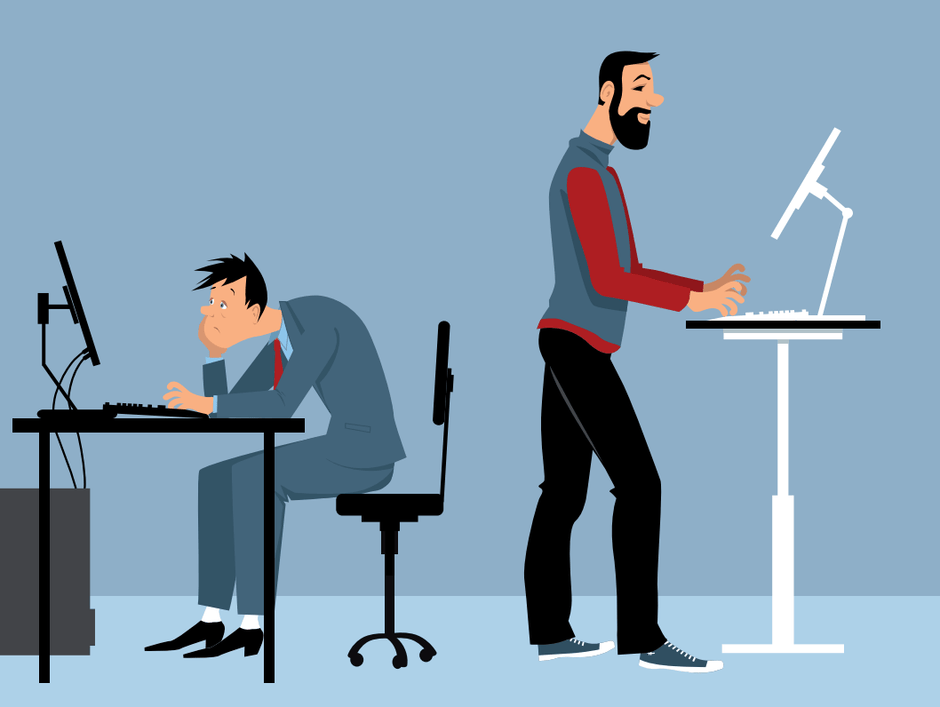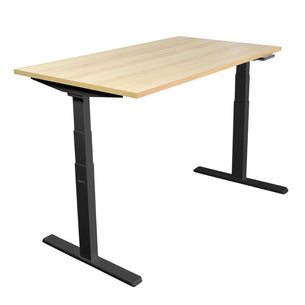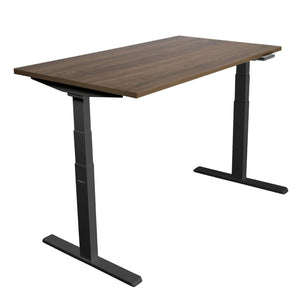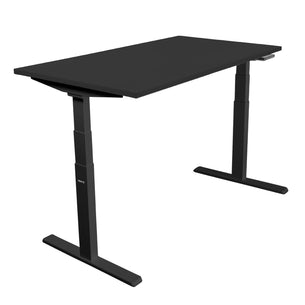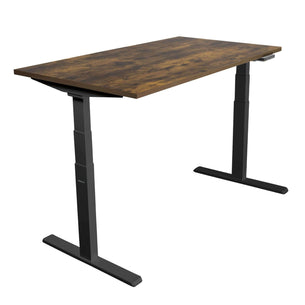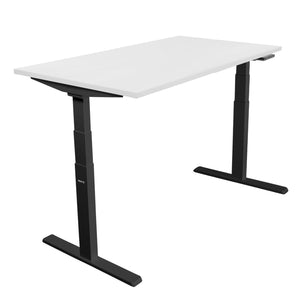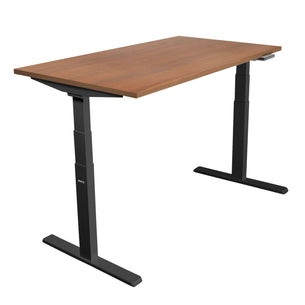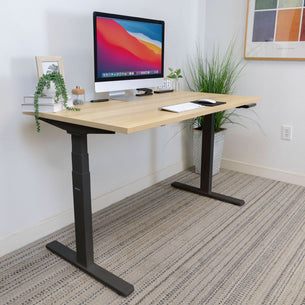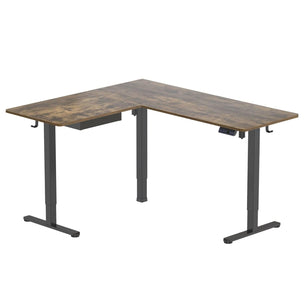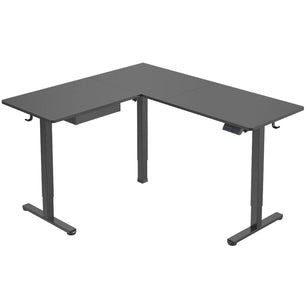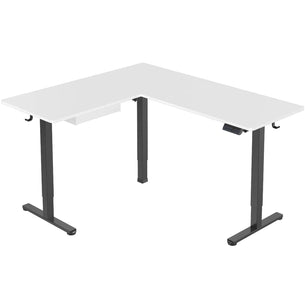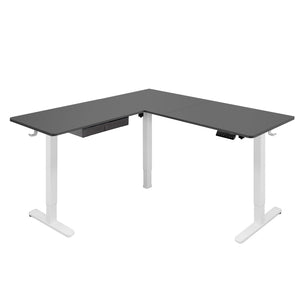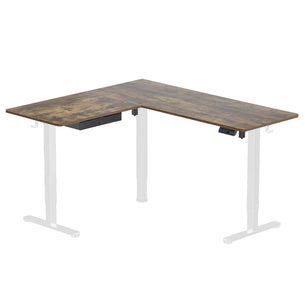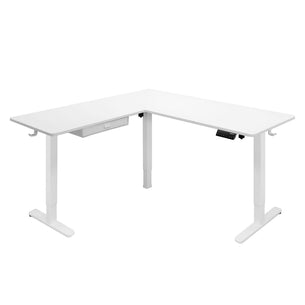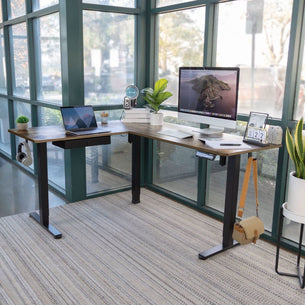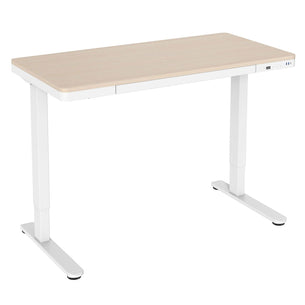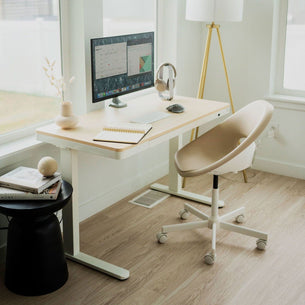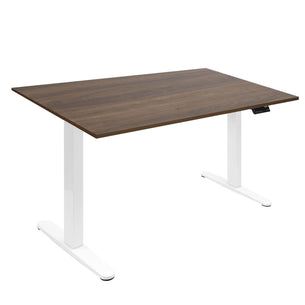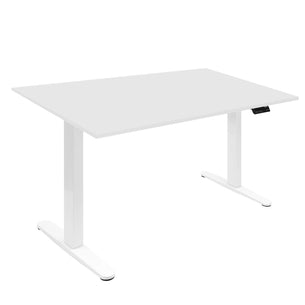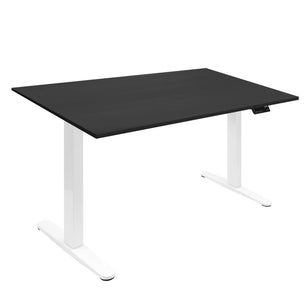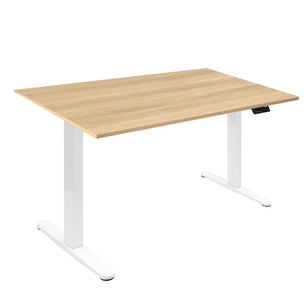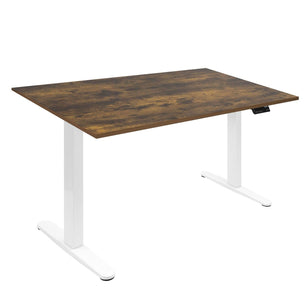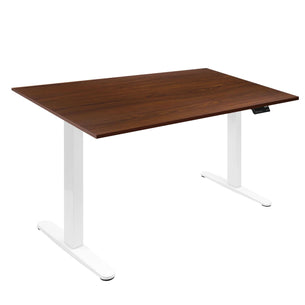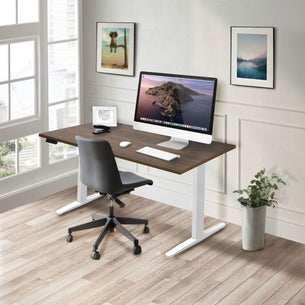Anyone who works a desk job knows that sitting all day can leave you feeling stiff and sore. What you may not know is that there can be serious long-term health consequences as well. A study done by Mayo Clinic1 found that people who spent their days seated “had a risk of dying similar to the risks of dying posed by obesity and smoking.” You read that right—sitting is the new smoking.
The problem is, getting up and moving during a busy workday is easier said than done. Sure, you could schedule breaks and walk around during phone calls, but what about the rest of the time when you need to be at your desk? Standing desks are the perfect solution. They are customizable from a simple monitor stands, to a dual monitor stand, to a full-on motorized standing desk with the full range of movement.
Which Standing Desk Should You Get?
Standing desks vary in size, style, and functionality. Choosing the right one means buying the desk that fits your needs and the amount of available space. What you want to avoid is purchasing a desk that allows you to only stand—as standing too long comes with its own set of problems.
The idea with an adjustable desk is to have a range of movement so that your workday doesn’t feel static. The goal is comfort, not forced physical labor.
Types of Standing Desks
Once you decide on your needs, there are four main types of standing desks available:
- Converters – Standing desk converters allow you to use your existing desk as a base. These can be desk mounted, single monitor, or dual monitor mounted. Converters can be adjusted manually or with an electric motor for smooth movement. The best part of this setup is that you can utilize what you already have and only take up extra space vertically.
- Full Desks – These are entire desk units with adjustable height features ranging from manual hand-cranks to luxury LED button-controlled height settings. Full desks can be customized to suit your needs—some motorized standing desk setups even come with timers that will let you know when to stand up. This style is a more integrated standing desk that gives your setup ergonomic flow. You can also purchase a standing desk frame and tabletop separately.
- Wall-mounted Workstations – If you’re low on floor space, have no fear. Wall-mounted workstations allow you to get all the benefits of a standing desk without taking up all of that precious real estate. These units hold your computer or monitor and mount up right on the wall, so you don’t have to expend an extra square foot.
- Mobile – Mobile standing desks are portable workstations. They come varied based on the tabletop size and the number of shelves desired. Each mobile unit is complete with wheels that allow you to bring your standing desk with you wherever you go. Mobile standing workstations are less bulky and give you full control over your workspace. And if you need to remain static, just set the brakes and use it as a normal desk.
Standing desks foster a healthy work environment, and regardless of which setup you choose, all models have incredible advantages over the traditional seated workspace.
Standing Desk Benefits
Standing desks are a hot trend right now when it comes to revamping the workplace. Businesses are making changes to open up floor plans and inviting décor to improve productivity and overall morale. Once you understand how to stand at a standing desk, the benefits go above and beyond aesthetics —they contribute to on-the-job health.
The BMJ Study
A study conducted by BMJ2 found that when a group of people used standing desks, they experienced decreased lower back pain and were more engaged with work. Just by choosing a sit-stand workstation, these people saw tangible differences in their work and well-being. Changes in your everyday routine can go a long way. The study showed the following improvements over a year:
- Standing time – As expected, those using standing desks spent more time on their feet. However, some of that time was spent walking and stretching, which increased the benefits exponentially.
- Decreased sitting time – After 12 months, standing desk users “sat for 82 fewer minutes per day.”
- Back pain – At the beginning of the experiment, participants initially reported that back pain prevented them from being able to carry out everyday tasks. As the study went on, “the odds of lower back problems preventing them from carrying out normal activities [was] less.” Standing desk users experienced less daily pain, which lead to higher productivity levels.
- Job performance and work engagement – Once they hit the 6-month mark, participants got better at their jobs, which benefited both the workers and the workplace as a whole. When individuals perform better, you cultivate an atmosphere of productivity.
- Occupational fatigue – Not only did standing desk users perform better at work, but they also found it easier to recover from work-related fatigue. Moving around will increase blood flow and get oxygen levels rising, ultimately giving you more energy.
- Sickness presenteeism – Sickness presenteeism is what often happens to workaholics. When you work while sick, your productivity and engagement with your work go down. The subjects who usedsit and stand desks found noticeable differences in “the scales of time management and mental-interpersonal demands and for overall sickness presenteeism.” Basically, when you feel better, you’re bound to get more done.
- Daily anxiety and quality of life – The people who used standing desks reported “improvement in their psychological, environmental, and overall quality of life.” These figures are hard to quantify, but what it comes down to is how you feel in your workplace. And anyone who feels a qualitative improvement in life satisfaction won’t care about the numbers of it!
It’s incredible to see all the benefits you can get by swapping out your workspace with a standing desk. Think about how much of your life you spend at work. It’s worth investing in a space that makes the most of that time. In the past, if you wanted to be more productive at your job, people suggested reorganizing your desk or making the commute a little easier. These pale in comparison with the benefits of a sit-stand workstation.
Ergonomics
Ergonomics is one of those buzzwords that has been gaining traction lately as businesses try to set themselves apart and maximize their productivity and overall effectiveness. All it means is creating an efficient space for work to be carried out smoothly. People want to work in a place that meshes well with the tasks at hand, and it’s even better if they enjoy being there. Standing desks are explicitly designed with ergonomics in mind. The following explains how ergonomics works in standing desk best practices:
- Natural transitions from sitting to standing allow you to move freely in your workspace, which decreases bodily aches like a strained neck or lower back pain.
- Customizability is a cornerstone of ergonomics. With all of the different styles of standing desks, you can personalize your space with the most efficient setup.
- When workers are less tired, more involved, and happier in their workspace, the entire business becomes more productive.
- Part of ergonomics is the way the space looks and feels. Standing desks are sleek as well as highly functional. Plus, when workers have an area that they enjoy using, the rest of their work will improve.
Before and After
Traditional workspaces offer little room for change. They usually consist of a desk and computer, set at a predetermined height, along with a chair where you spend your day sitting for prolonged periods of time. This type of setup worsens your posture and causes musculoskeletal pain over time. Humans are meant to move around, so any static position you hold for long periods of time is unnatural and bound to have negative effects.
Ergonomic design works with you, not against you. With a standing desk setup, you can listen to your body without having to put much thought into it. When the little things are taken care of, you can focus on the vital work that needs to get done. That’s the beauty of ergonomics!
Who Benefits From Standing Desks?
All different types of workplaces can utilize standing desks.
- Traditional Business – A traditional office is the first place you’re likely to find sit and stand desks. Where there were once rows of cubicles and uncomfortable chairs, many companies have taken on new layout designs that are meant to open up and renew drab office spaces. Standing desks are a beautiful, practical way for workplaces to implement this ergonomic restructuring.
- Education – Schools are a great place to utilize standing desk technology. To optimize a teacher’s role in the classroom, mobile computer stands can be used to make the classroom feel less static.
- Medical – Hospitals and other medical offices can also benefit from standing desk technology. Mobile setups are ideal for fast-paced environments and give medical professionals the ability to have a reliable workspace that can get around with them. Medical settings also generally require all the space they can get, so wall mounts that take up less room are ideal.
- Home – Working from home demands a proper home office. Creating a distinction from home and work discourages distractions and increases productivity. Bring sit-stand desk ergonomics into your home that will encourage movement without tempting you to leave your workspace.
Any activity that has people sitting for long periods can benefit from the transition to sit and stand workspaces.
Building a Better Business
Implementing technology like standing desks in the workplace is all about investing in the future. The cost of making the switch to standing desks pays for itself in things like employee satisfaction and long-term health. When a business takes care of its people and plans for the long run, the longevity of that company’s success will increase.
When businesses only focus on quick-fixes and don’t take the time to create a solid foundation, everyone suffers. These temporary solutions might cost less in the beginning, but employees will feel undervalued, and the entire office culture suffers.
Office Culture
Office culture is the personality of a workplace, consisting of everything from values and core beliefs to interactions between coworkers and their superiors. This culture sets the tone for how people feel in the workplace and how hard they are working, and ultimately, how smoothly the business runs. Once individual workers start feeling positive changes a sit and stand desk provides, the entire culture within that space improves.
- Show that you care – When businesses invest in technology like standing desks, it shows that they care about the health and safety of their workers. This validation creates a culture where people feel taken care of and valued.
- Make it easy – Sit and stand desks make it effortless for people to do their jobs. The ergonomic design takes your capabilities and duties into consideration, creating a space that maximizes the employees’ potential.
- Listen to employees – When implementing sit and stand workspaces, including employees in the decision-making process, benefits everyone. The people using these desks are experts in the best way to do their jobs. When they are empowered to make decisions about the equipment in their office, it shows that they are valued.
- Take action – Sit and stand desks make tangible improvements in the lives of its users. It is easy to say you want a safe and productive workspace, but swapping out traditional desks with standing workspaces shows workers that you mean it.
The Benefits Will Speak For Themselves
When it comes to standing desks, everyone can benefit. It’s more than a superficial trend to make a space look aesthetically pleasing—although that is a bonus. Standing desks make a tangible difference in the quality of life by making people healthier, happier, and more productive.
If you are a business owner looking to revitalize your office space and inspire workers, sit and stand workstations will take you there. Everyone can benefit from getting up on their feet more often and changing what it means to be working a desk job.
Sources:

